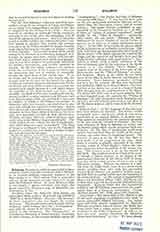

Solomon, PSALMS OF, eighteen apocryphal psalms, extant in Greek, probably translated from a Hebrew, or an Aramaic original, commonly assigned to the first century B.C. They contain little of originality and are, for the most part, no more than centos drawn from the Psalms of David. In them Messianic hope is not bright; a gloom enshrouds that hope—the gloom caused by Pompey’s siege of Jerusalem [see Apocrypha. I, (3)].
SOLOMON, ODES OF, forty-two lyric poems, an apocryphal work, recently discovered and published (1909) by J. Rendel Harris. History.—The existence of these apocryphal odes was known by various references. The pseudo-Athanasian Synopsis Sanetas Scripturae (sixth century) lists the “Antilegomena” and adds Greek: sun ekeinois de kai tauta erimentai… psalmoi kai ode Solomontos. The “Stichometry” of Nicephorus, Patriarch of Constantinople (beginning of ninth century), in like manner includes among the “Antilegomena”, “the Psalms and Odes of Solomon containing 2100 stichoi”. It may be that these odes are the new psalm-book written for Marcion and excluded from the Muratorian Canon (end of second century). The psalmoi idiotikoi, prohibited as noncanonical by the Council of Laodicea (c. A.D. 360), if taken as “psalms of personal experience”, might readily be the “Odes of Solomon“. Lactantius (Div. instit., IV, xii) writes: “Solomon ita dicit: Infirmatus est uterus Virginis et accepit fcetum et gravata est, et facta est in multa miseratione mater virgo”. In the MSS. of Lactantius the gloss is added in Ode undevigesimo, or in Psalmo undevigesimo. Ode XIX, verse 6, of the Syriac translation (discovered by Harris) reads:” (The Spirit) opened the womb of the Virgin, and she conceived and brought forth, and the Virgin became a Mother with many mercies”. Lactantius is clearly citing a Latin translation of the Odes of Solomon, done by the beginning of the fourth century A.D. The Sahidic “Pistis Sophia”, a Gnostic work of the Copts of the latter part of the third century, uses the “Odes of Solomon” as canonical Scripture. Harris (p. 81) thinks he has found traces of the Odes in Saints Irenaeus and Clement of Alexandria. These important apocryphal writings had been lost for centuries till they were discovered and published (1909) by J. Rendel Harris, after they had lain on his shelves two years in a heap of Syriac MSS. brought from the neighborhood of the Tigris. The Syriac MS. of the odes is of paper probably three or four hundred years old, contains the “Psalms of Solomon”, the odes (incomplete in the beginning and the end), coarsely written, pointed here and there in the Nestorian manner, and at times with the Jacobite vowels.
Original Text.—(a) The language of the odes may have been Hebrew or Aramaic. Our Syriac version is probably from a Greek text, which in turn was a translation of an original Hebrew or Aramaic text. This opinion is warranted by the continual grouping of the odes with the “Psalms of Solomon”, the constant reference of them to Solomon as author, and the Semitic spirit which equally permeates both sets of lyrics. (b) The time of composition would seem to have been not later than the middle of the second century, nor earlier than the beginning thereof. The terminus ad quem is set by the fact that there is some doubt as to the canonicity of the odes. Such doubt is scarcely intelligible, especially in the third-century author of “Pistis Sophia”, unless the odes were composed before the middle of the second century. The terminus a quo is set by the content of Ode XIX. The painlessness of the Virgin birth (verse 7), though a logical corollary to the dogma of the supernatural character of the Divine birth of Jesus, is an idea which we find no trace of even so late as the Johannine writings. Whereas the absence of a mid-wife from the Virgin birth (verse 8) is a detail which clearly parallels these odes with the apocryphal Gospels of the Infancy and prohibits us from assigning Ode XIX to a period earlier than the beginning of the second century. (c) The author is considered by Harris and Hausleiter (Theol. Litbl., XXXI, no. 12) to have been a gentile in a Palestine Judeo-Christian community. Harnack thinks that the Grundschrift is Jewish and all Christian sentiments are the super-added work of a Christian interpolator. Cheyne (Hibbert Journal, October, 1910) agrees with Harnack.
Importance.—This latest find of Mr. Harris is one of the most important contributions ever made to extant apocryphal Biblical literature. The importance has been greatly exaggerated by Harnack. With his usual keen sense of sources, the Berlin professor scents here a unique source of the Johannine tradition; in the “Odes of Solomon“, he tells us, we have the very “quarry wherefrom the Johannine blocks have been hewn” (p. 111). We have already given two ideas of Ode XIX which are most decidedly post-Johannine; others still could be given. The points common to both odes and the Fourth Gospel are striking,—for instance, adopted sonship founded on love of Jesus,—”because I love Him, the Son, I shall be a son” (Ode III, 9). Odes IV and VI have much of Christian thought. An hypothesis, hitherto unsuggested, yet far likelier than Harnack’s wild quarry-dream, is that the odes are a new link, long lost, of the Johannine tradition; that they draw their Christian sentiment from St. John’s Gospel. The traditional view in regard to the Apostolic authority of the Gospel is strengthened by a new witness,—a Judeo-Christian genius, who perhaps works over some pre-existing and baser Jewish metal. Whoever the author is, he very likely tried to combine the ideas of the Sapiential Books with those of the Fourth Gospel.
WALTER DRUM

